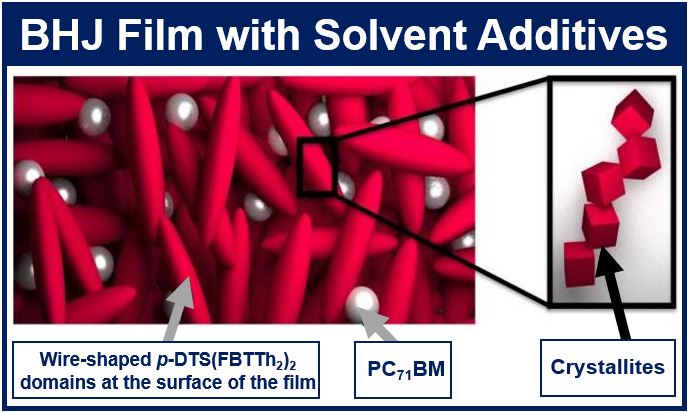Scientists at the Department of Energy’s Oak Ridge National Laboratory have found a way of making solar panels and semiconductor devices less costly and more efficient thanks to a simple solvent.
The ultra-thin films used in solar panels and semiconductor devices can aso be manufactured more easily now, the researchers explained.
Typically the films – used by BHJs (organic bulk heterojunction) solar cells to convert sunlight into electricity – are made in a solution by mixing together conjugated polymers and fullerenes, carbon molecules shaped like soccer balls, known as buckyballs.
The scientists discussed their findings in the journal Scientific Reports (citation below).
 Fullerenes appear as small silver spheres spread consistently throughout a network of polymers in this schematic illustration of the morphology of a BHJ film with solvent additives. (Image: ornl.gov)
Fullerenes appear as small silver spheres spread consistently throughout a network of polymers in this schematic illustration of the morphology of a BHJ film with solvent additives. (Image: ornl.gov)
Then, the mixture is spin cast on a rotating substrate to make sure it is uniform, and sent to post-processing to be heated and allowed to cool slowly, in order to remove internal stresses and toughen it (annealed). Annealing makes the material less hard, but tougher, i.e. easier to work with.
Simple solvent may transform the process
BHJs are more pliable than crystalline silicon. However, the annealing process is very time consuming. Postdoctoral researcher, Nuradhika Herath, and colleagues say that a simple solvent may make thermal annealing a thing of the past.
Herath said:
“Optimizing a film’s morphology is the key to improving device performance. What we want to find out is the relationship between the blend structures and photovoltaic performance.”
Finding out how to tune the film’s morphology is just as important as determining why film morphologies are more favorable than others, the scientists explained.
Herath and team compared thermal annealing with a method where a small amount of solvent is added. The solvent aids in dissolving the fullerenes within the mixture and helps to make the film’s structure more uniform.
The aim is get the most uniform mixture of polymers or other molecules (light absorbing molecules) and fullerenes throughout the film.
The less uniform a mixture is, the more clusters will form that cause passing electrons to get absorbed, which weakens the film’s ability to transport electrical current, which in turn reduces the device’s performance.
Because the films are usually about 100 nanometers thick (human hair is around 75,000 nanometers in diameter) and the depth profile of the composition is highly complex, scientists need special instruments to measure the material’s morphology. For this, they turned to neutron scattering.
After mixing and spin casting to different samples – one with solvent additive and the other annealed – the researchers put both films under the eye of a Magnetism Reflectometer.
The Magnetism Reflectometer (MR) provided them with an accurate depiction of the structural profiles, which revealed exactly how the fullerenes and polymers were arranging themselves in both films. The difference between them was clear.
Film performed better with solvent
While the sample with the solvent additive was amazingly consistent throughout and performed better, the annealed sample’s morphology clearly showed considerable separation between fullerenes and polymers.
MR Lead Instrument Scientist Valeria Lauter, said:
“The reason is that when we use a solvent instead of annealing, the sample dries very slowly, so there is enough time for the system to become fully optimized. We see that additional annealing is not necessary because, in a sense, the system is already as perfect as it can be.”
Neutron reflectometry leaves any material transparent, Lauter explained, making it a powerful method.
Lauter added:
“Instead of searching for the key that opens the metaphorical black box that prevents researchers from seeing a material’s atomic structure, neutrons simply go straight through it, giving researchers both qualitative and quantitative information about their problem.”
The information obtained from neutrons will help increase solar cell efficiency as well as streamlining the process of manufacturing them.
By adding the solvent to optimize BHJ film morphology, there may be no need to invest more into a less effective process – saving money, time, and resources.
Herath said:
“In addition, optimization of photovoltaic properties provides information to manufacture solar cells with fully controlled morphology and device performance. These findings will aid in developing ‘ideal’ photovoltaics, which gets us one step closer to producing commercialized devices.”
Citation: “Peculiarity of Two Thermodynamically-Stable Morphologies and Their Impact on the Efficiency of Small Molecule Bulk Heterojunction Solar Cells,” Nuradhika Herath, Sanjib Das, Jong K. Keum, Jiahua Zhu, Rajeev Kumar, Ilia N. Ivanov, Bobby G. Sumpter, James F. Browning, Kai Xiao, Gong Gu, Pooran Joshi, Sean Smith & Valeria Lauter. Scientific Reports 5, Article number: 13407 (2015). DOI: 10.1038/srep13407.
